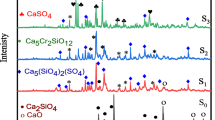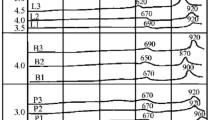Abstract
The main results of the investigation into the interaction of glass melts with refractory titanium dioxide have been considered. Titanium dioxide has been shown to partially dissolve in the sodium-borosilicate glass. It has been found that by incorporating into the glass structure a titanium cation isomorphically replaces silicon and forms a single strong titanium-boron-silicon-oxygen skeleton, which allows the wear- and heat-resistances of the composition to be enhanced.
Similar content being viewed by others
References
Shilo, A.E., Kukharenko, S.A., Klimenko, N.G., et al., The Effect of Diffusion Processes on the Interaction in Multicomponent Silicate Systems, J. Superhard Materials, 2008, vol. 30, no. 2, pp. 105–114.
Khodakovskaya, R.Ya., Khimiya titansoderzhashchikh stekol i sitallov (Chemistry of Titanium-Containing Glasses and glass ceramics), Moscow: Khimiya, 1978.
Khodakovskaya, R.Ya. and Pavlushkin, N.M., Interrelation of the Structure of Aluminosilicate Glasses and Liquation and Crystallization of Them Caused by the Addition of TiO2, Fizika i Khimiya Stekla, 1976, vol. 2, no. 3, pp. 246–252.
Murashkevich, A.N., Lavitskaya, A.S., Barannikova, T.I., and Zharskii, I.M., Infrared Absorption Spectra and the Structure of TiO2-SiO2 Composites, J. Applied Spectroscopy, 2008, vol. 75, Sept.–Oct., pp. 724–728.
Kopysov, V.A., Buler, P.I., Toporishchev, G.A., and Semenov, N.N., Anodic Dissolution of Titanium in a Silicate Glass Melt, Fizika i Khimiya Stekla, 1978, vol. 4, no. 4, pp. 498–500.
Romashchenko, Yu.N., Brytov, I.A., Antoeva, T.M., et al., X-Ray Spectrum Analysis of the Chemical Bond Nature in Glasses of the SiO2-TiO2 System and Crystalline Titanates, ibid., 1981, vol. 7, no. 4, pp. 391–396.
Shtin, A.P. and Slepukhin, V.K., On the Structural Role of Titanium in Potassium-Aluminophosphate Glasses from the Data on the Study of the Kinetics of Their Chemical Decomposition, ibid., 1979, vol. 5, no. 2, pp. 171–177.
Klyuev, V.P., Dependence of Dilatometric Properties of Glasses on Their Structure. II. Silicate, Phosphate, Fluorine-, and Titanium-Containing Glasses, ibid., 2006, vol. 32, no. 2, pp. 271–285.
Tavgen’, V.V., Rodtsevich, S.P., and Minkevich, T.S., Alkali Titanium-Silicate Glasses for White Glass Enamels with Enhanced Corrosion Stability, Glass and Ceramics, 2005, no. 7, pp. 31–33.
Malinin, Yu.S., Ryazin, V.P., and Volkov, O.S., Quantitative X-Ray Diffraction Analysis of a Clinker, Trudy NIITsement, 1962, issue 17, pp. 3–12.
Plyusnina, I.I., Infrakrasnye spektry silikatov (Infrared Spectra of Silicates), Moscow: Mosk. Gos. Univ., 1967.
Energii razryva khimicheskikh svyazei, potentsialy ionizatsii i srodstvo k elektronu: Spravochnik (Energies of Chemical Bond Rupture, Ionization Potentials, and Affinity for Electron: Handbook), Kondrat’ev, V.N., Ed., Moscow: Nauka, 1974.
Annen, A.A., Khimiya stekla (Chemistry of Glass), Leningrad: Khimiya, 1970.
Nakamura, T., Suginohara, Y., and Yanagase, T., Infrared Absorption Spectra of Silicate Glasses Containing TiO2, J. Ceram. Soc. Jap., 1976, vol. 84, no. 970, pp. 293–298.
Plyusnina, Infrakrasnye spectry mineralov (Infrared Spectra of Minerals), Moscow: Mosk. Gos. Univ., 1976.
Mikheev, V.I., Rentgenometricheskii opredelitel’ mineralov (Roentgenometric Identifier of Minerals), Moscow: Gosgeoltekhizdat, 1857, vol. 1.
Powder Diffraction File Search Manual, ASTM, USA, 1976, no. 25-177.
Pavlova, G.A. and Amatuni, A.N., Physicochemical Properties of Glasses with Low Thermal Expansion Coefficients in the SiO2-TiO2 System, Izv. USSR Acad. Sci., Inorg. Mater., 1975, vol. 11., no. 9, pp. 1686–1689.
Rao, Bh.V.J., Influence of TiO2 on Properties of Glasses in the System K2O-PbO-SiO2-TiO2 and Its Relation to Structure, J. Amer. Ceram. Soc., 1963, vol. 46, no. 3, pp. 107–114.
Pavlushkin, N.M., Khodakovskaya, R.Ya., Orlova, L.A., and Orlov, V.V., Studies of Structural Changes in Titanium-Containing Glasses in Microliquation of Them by EPR, in Likvatsionnye yavleniya v steklakh (Liquation Phenomena in Glasses), Leningrad: Nauka, 1969, pp. 109–113.
Author information
Authors and Affiliations
Additional information
Original Russian Text © S.A. Kukharenko, A.E. Shilo, P.P. Itsenko, A.N. Kutsai, 2010, published in Sverkhtverdye Materialy, 2010, Vol. 32, No. 6, pp. 41–54.
About this article
Cite this article
Kukharenko, S.A., Shilo, A.E., Itsenko, P.P. et al. The effect of titanium dioxide on the structure of silicate multicomponent glasses. J. Superhard Mater. 32, 396–405 (2010). https://doi.org/10.3103/S1063457610060055
Received:
Published:
Issue Date:
DOI: https://doi.org/10.3103/S1063457610060055




